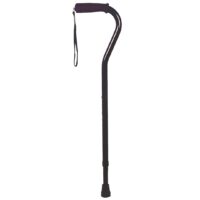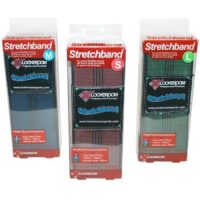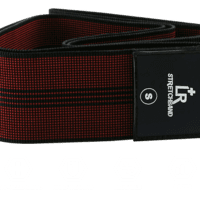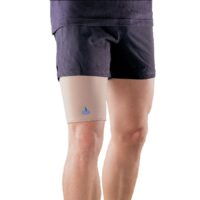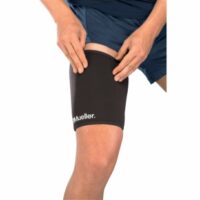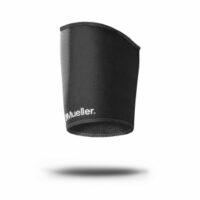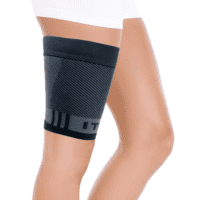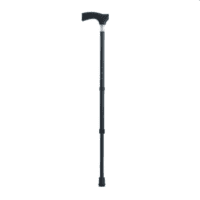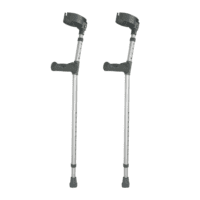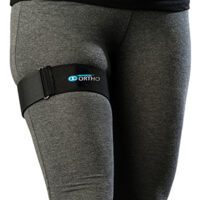Proximal Hamstring Tendinopathy
Article by Zoe Russell

Proximal Hamstring Tendinopathy
What is Proximal Hamstring Tendinopathy?
Proximal Hamstring Tendinopathy (PHT) refers to an injury affecting the hamstring tendon at its attachment point to the pelvis’s ischial tuberosity. This condition often causes gluteal pain and is typically triggered by overuse or repetitive strain on the hamstring muscles.
Why does Proximal Hamstring Tendinopathy occur?
The primary cause of PHT is repetitive overloading of the hamstring muscles, particularly in activities requiring hip extension, such as running and sprinting. These repetitive movements lead to tendon inflammation and degeneration when the tendon cannot repair itself effectively.
Read more: Tendinopathy Causes | Hamstring Injuries
How do you Identify Proximal Hamstring Tendinopathy?
The onset of PHT is typically gradual, with pain manifesting as a deep ache in the buttocks. It often radiates down the thigh, particularly during activities that stress the hamstring, such as running, climbing, bent over running eg hockey or prolonged sitting.
What increases your risk of PHT?
Several factors can raise the risk of developing PHT, including prior hamstring injuries, muscle weakness, poor gluteal strength, and imbalances in pelvic alignment. Training errors, such as sudden increases in activity or incorrect techniques, are also contributing factors.
Phases of Tendinopathy
Proximal hamstring tendinopathy follows distinct stages:
- Reactive tendinopathy – the early stage marked by pain and swelling.
- Tendon dysrepair – characterised by ongoing degeneration and possible tissue damage.
- Degenerative tendinopathy – where long-term tendon damage may occur without proper treatment.
Read more: Tendinopathy Phases
How is PHT diagnosed?
A physiotherapist will evaluate the patient’s medical history, perform physical tests, and may order imaging studies like MRI to confirm the diagnosis.
Read more: Hamstring Injury Diagnosis
What treatments work best for PHT?
Effective treatment involves load management, tailored exercises, and pain relief strategies. Physiotherapists develop rehabilitation plans to strengthen the hamstring tendon while reducing pain triggers. Eccentric strengthening exercises are especially helpful when introduced gradually.
Latest Research
Recent studies, such as a 2023 systematic review, highlight the importance of progressive load management in tendon recovery. Emerging treatments like platelet-rich plasma (PRP) injections are being explored but require further research for effectiveness (Smith & Johnson, 2023).
What to Do?
Proximal hamstring tendinopathy is a common injury, especially among athletes. Early intervention and consistent rehabilitation are key to successful recovery. For tailored treatment, please consult your physiotherapist to develop a plan suited to your needs.
Rochedale - Call 38410277
Book Online: RochedaleSalisbury - Call 32751044
Book Online: SalisburySandgate - Call 32691122
Book Online: Sandgate
Related Articles
- Hamstring Pain: Offers insights into various hamstring injuries, highlighting their similarities and differences with Proximal Hamstring Tendinopathy.
- Tendinopathy: Causes, Symptoms, And Effective Treatments: Discusses the broader category of tendinopathies, providing a deeper understanding of tendon injuries.
- Hamstring Strain: Details on hamstring strains, a common issue among athletes, which could be relevant for understanding hamstring health.
- Tendinopathy Phases: Explains the different stages of tendinopathy, offering a deeper dive into how these conditions progress and are managed.
- Common Tendinopathies: An Overview of Tendon Injuries: A comprehensive look at various tendinopathies, placing Proximal Hamstring Tendinopathy in a broader context.
- Piriformis Syndrome: Although focusing on a different condition, this article can help differentiate between hamstring-related pain and other similar conditions.
- Greater Trochanteric Pain Syndrome (GTPS): Discusses hip and groin pain, which might be relevant given the proximity to the hamstring area.
- Hip Adductor Tendinopathy: Provides insights into another tendinopathy in the hip area, which could be mistaken for or occur alongside hamstring issues.
- Gluteal Tendinopathy: Offers information on tendinopathy affecting the glutes, a region closely related to the hamstring.




